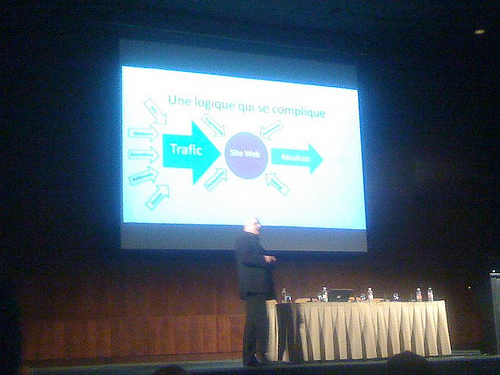Infopresse360 Day on Web Analytics: Summary of Jacques Warren's conference
Jacques Warren was commissioned to introduce Web analytics (WA) to the people in the room. He asks very simple questions, but how fundamental.
So why do we measure a website?
Senior management is often reluctant to delve into numbers from the web because they don't know the majority of metrics used for a site. It is therefore necessary to justify its presence in order to demonstrate its value and its contribution to the profitability of the company. The web now impacts several units in the company and modulates its communication as well as its strategy. It is therefore necessary to make the management understand that the WA is a decision support tool which has the same value as a CRM, ERP or BI tool.
What should we measure?
We must measure success, in order to know if we are executing the web strategy well according to the objectives established beforehand. This answer seems to be quite basic, but let's understand that few decision makers establish targets to reach when launching a web campaign. At best, they will look at visits as the main indicator. At worst, they will say that this exercise is done to increase brand awareness (least measurable indicator of modern marketing), because lack of resources/knowledge/time, they cannot dwell on it concretely.
In the end, Warren proposes to do the following exercise in order to find what we should measure: Imagine being in a meeting and you want to double the budget allocated to you. What metrics will you use to convince management?
But where to start?
By simple logic, three elements must be measured:
- Measure input: traffic sources, their type (organic, PPC, banners, affiliation) and their contribution
- Measure processing: the website by its ergonomics, its persuasive elements and its performance
- Result: KPIs and targets to be achieved.
We don't know our consumers
The WA comes from behavioral analysis, analysis of the clickstream done on a site. This explains the What to us. What they are seen, asked for or done. The catch is that it doesn't say whether they enjoyed their experience. This corresponds to the why of the visit or to the attitudinal analysis or the Voice of Customer . This can be done in several ways, including the famous survey. Jacques omitted to mention other methods that are worth their thought in gold such as the comments received on your site via the contact form or the people who comment on your blog or your Facebook group. All of its data is equivalent to focus groups and provides a qualitative richness that often explains fluctuations on your site.
Can also :
- Do A/B or multivariate tests
- Segment visitors and offer personalized content
- Perform reputation analysis
- Benchmark yourself against the competition with sites like www.hitwise.com or www.compete.com (US data only).
Implementing the culture of measurement
The problem in organizations is that the WA is considered at the end of the process and is therefore seen as an operational step rather than a strategic one. Here are some steps to take:
- Establish a process by positioning the WA at the start of the process
- Choose the right people. The Champions
- Make room for a web analyst
- Find the department that should oversee web measurement
Jacques recommends communication-marketing rather than IT. For my part, I believe that it should be integrated into the client information system team, i.e. the BI people, and as I mentioned earlier, the WA will soon be integrated with the other measurement tools (CRM, ERP) in order to have a holistic view of the customer, regardless of the channel they take. Jean-François talks about it in his article and you will see several similarities with the Trinity proposed by Avinash Kaushik.


-1.png)
-1.png)






